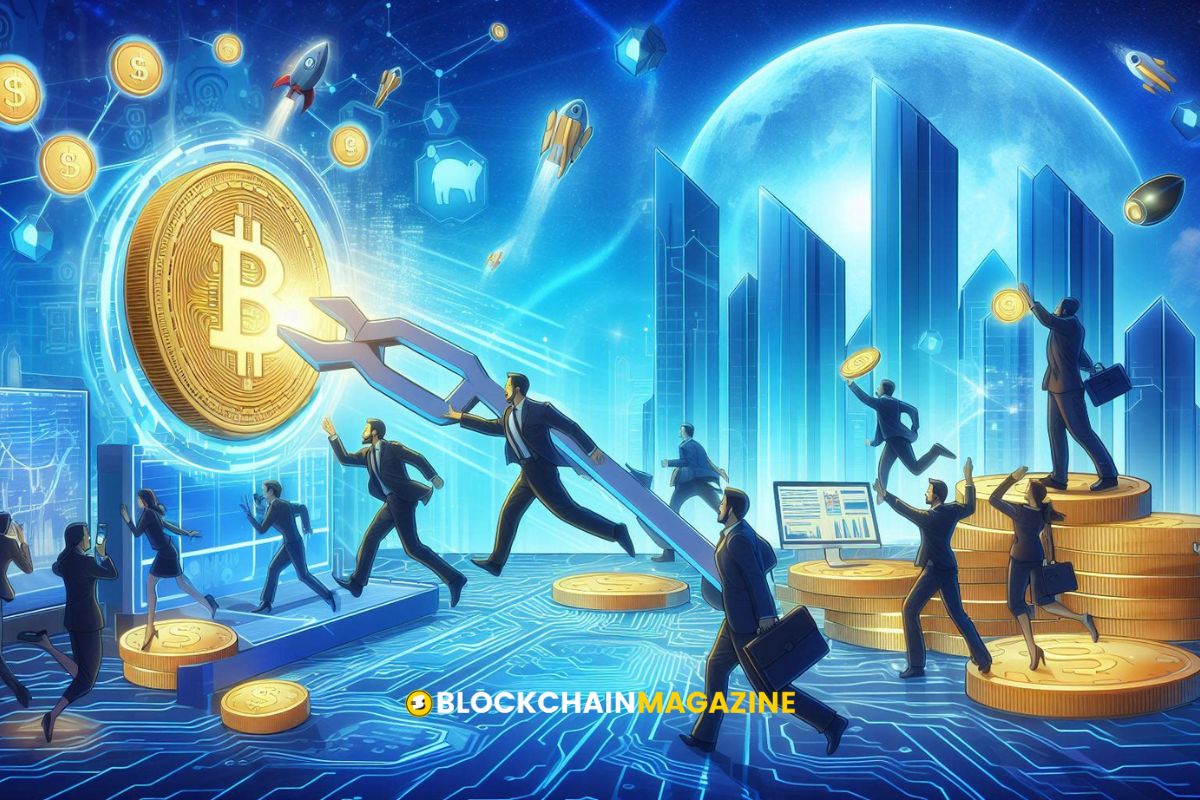Behind the Scenes of a Blockchain Transaction: An Amazing Step-by-Step Journey Guide For You
Blockchain technology has revolutionized the way we think about digital transactions, offering a secure, transparent, and decentralized method for transferring assets. In this article, we will take you on an amazing step-by-step journey through the intricate process of a blockchain transaction, from initiation to final recording on the immutable ledger. Whether you’re a beginner or an experienced enthusiast, this guide will provide valuable insights into the fascinating world of blockchain transactions.
Key Takeaways
- A blockchain transaction begins with the initiation phase, where necessary details like sender, recipient, and amount are specified.
- Verification and validation by nodes ensure the authenticity and integrity of the transaction through consensus mechanisms.
- The transaction is broadcast across the network, where it faces potential network latency and conflict resolution challenges.
- Inclusion in a block involves mining or validation, where transaction fees play a crucial role.
- Final confirmation and recording on the blockchain ensure the transaction is secure, transparent, and immutable.
Initiating a Blockchain Transaction
Details Required for Initiation
A blockchain transaction begins when a user decides to transfer digital assets or cryptocurrencies to another user. This process requires specific details such as the sender’s and recipient’s information, the amount to be transferred, and any other pertinent data. Accurate information is crucial to ensure the transaction proceeds smoothly.
Common Use Cases
Blockchain transactions are utilized in various scenarios, including peer-to-peer payments, smart contracts, and supply chain management. These use cases highlight the versatility and efficiency of blockchain technology in different sectors.
User Experience
The user experience of initiating a blockchain transaction can vary depending on the platform used. Generally, users interact with a cryptocurrency wallet, which provides an interface to the blockchain. The process is designed to be user-friendly, but understanding the steps involved can enhance the overall experience.
Initiating a blockchain transaction is the first step in a complex yet fascinating journey that ensures secure and transparent digital asset transfers.
Verification and Validation Process
Role of Nodes
Once a transaction is initiated, it is broadcast to the nodes on the blockchain network. Each node plays a crucial role in verifying the transaction by checking whether the sender has sufficient funds and if the transaction meets the necessary criteria. This ensures that only legitimate transactions proceed further.
Consensus Mechanisms
After verification, the transaction undergoes validation, which involves solving a complex mathematical problem. This process, known as proof of work or proof of stake, depends on the blockchain technology being used. This step ensures the transaction’s legitimacy and the sender’s authority to make the transfer.
Importance of Verification
Before entering the mempool, transactions are validated by the nodes themselves. This validation process filters out transactions with improper addressing, invalid signatures, or data mismatches. Only valid transactions get to be a part of the mempool, ensuring the integrity and stability of the blockchain network.
The verification and validation process is essential for maintaining the security and trustworthiness of the blockchain. Without these steps, the network would be vulnerable to fraudulent activities and tampering attempts.
Transaction Propagation Across the Network
Broadcasting the Transaction
Once a transaction is initiated, it is broadcasted to the entire network of nodes. Each node that receives the transaction will validate it and then propagate it further. This ensures that the transaction is quickly disseminated across the network, allowing for a more efficient and secure process.
Network Latency
Network latency can impact the speed at which a transaction is propagated. Factors such as the geographical distribution of nodes and the current network load can cause delays. However, blockchain networks are designed to handle these issues, ensuring that transactions are processed in a timely manner.
Handling Conflicts
Conflicts can arise when multiple transactions are broadcasted simultaneously. Blockchain networks use consensus mechanisms to resolve these conflicts, ensuring that only valid transactions are added to the ledger. This process maintains the integrity and accuracy of the blockchain.
By securing transactions through cryptographic principles, blockchain ensures immutability and integrity of data.
Inclusion in a Block
Once a transaction is verified, it is ready to be included in a block. This process is crucial for maintaining the integrity and order of the blockchain. A block is essentially a container that holds multiple transactions along with other important data, such as a reference to the previous block, a timestamp, and a unique hash. The reference to the previous block is what links all blocks together, forming a chain.
Mining and Validators
In many blockchain networks, the process of adding a new block is carried out by miners or validators. These participants use computational power or stake their assets to solve complex cryptographic puzzles. Once a puzzle is solved, the new block is proposed to the network for validation. This ensures that all nodes in the network agree on the new block’s validity before it is added to the blockchain.
Block Formation
The formation of a block involves gathering verified transactions from the transaction pool and assembling them into a single block. This block is then subjected to a hashing process, which generates a unique identifier for the block. The block also includes a reference to the previous block’s hash, ensuring the continuity of the blockchain.
Transaction Fees
Transaction fees play a significant role in the inclusion of transactions in a block. Users often attach fees to their transactions to incentivize miners or validators to include their transactions in the next block. Higher fees can lead to faster inclusion, especially during times of high network congestion.
The integrity of the blockchain relies heavily on the meticulous process of block formation and validation. This ensures that every transaction is securely recorded and immutable.
Confirmation and Finality
Confirmations Explained
Once a block is closed, a transaction is complete. However, the block is not considered to be confirmed until five other blocks have been validated. This confirmation process takes the network about one hour to complete because it averages just under 10 minutes per block. The first block with your transaction and five following blocks multiplied by 10 equals 60 minutes.
Achieving Finality
After the transaction is recorded, it needs to be confirmed by the nodes on the Blockchain network. This confirmation process involves checking the authenticity and accuracy of the transaction details and ensuring that it complies with the rules and regulations of the Blockchain network. Once confirmed, the transaction is distributed across the entire network of nodes, which adds it to their copy of the ledger. This ensures that all nodes have an up-to-date and accurate copy of the ledger.
Security Implications
To replace a pending transaction, set up a similar transaction with the same ETH value, give the same nonce for the transaction, add a higher transaction fee, and voila! Thanks to the higher transaction fee, your new and improved transaction will most likely get confirmed first and the pending transaction will be dropped. This is essentially what happens when you “speed up” or “cancel” a transaction in MetaMask.
Recording on the Blockchain
Immutable Ledger
Once a transaction is validated, it is recorded on the blockchain. The transaction is added to a block, which is then appended to a chain of blocks in chronological order. This forms an unalterable and transparent record of all transactions on the blockchain. Each block contains a unique hash and the hash of the previous block, ensuring the integrity and immutability of the ledger.
Transparency and Auditability
Blockchain can immutably record various data points, such as transactions, votes in elections, product inventories, and more. This transparency allows for easy auditing and verification of data. For instance, semler scientific embraces bitcoin as part of its bold treasury strategy, showcasing the diverse applications of blockchain technology.
Accessing Transaction History
Once recorded, transactions on the blockchain can be accessed and verified by anyone on the network. This open access ensures that all participants can review the transaction history, enhancing trust and accountability. Top 5 platforms for tracking crypto transactions provide tools to easily navigate and audit these records, making blockchain a reliable source for historical data.
Potential Challenges and Solutions
Scalability Issues
One of the primary challenges faced by blockchain networks is scalability. As the number of transactions and users increases, the capacity of traditional blockchain systems to handle the load becomes a limiting factor. The most notable blockchain network, Bitcoin, has encountered scalability bottlenecks, resulting in slower transaction times and higher fees during periods of peak demand.
Innovative solutions and ongoing research are being actively explored to overcome these scalability challenges. Some of the most promising approaches include:
- Sharding: Dividing the blockchain into smaller, more manageable pieces.
- Layer 2 solutions: Offloading some transactions to secondary layers to reduce the load on the main blockchain.
- Consensus algorithm improvements: Enhancing the efficiency of consensus mechanisms to process more transactions per second.
Energy Consumption
Blockchain networks, especially those using Proof of Work (PoW) consensus mechanisms, consume significant amounts of energy. This high energy consumption has raised environmental concerns and calls for more sustainable alternatives.
To address this issue, researchers and developers are exploring various solutions, such as:
- Transitioning to Proof of Stake (PoS) or other energy-efficient consensus mechanisms.
- Implementing hybrid models that combine PoW and PoS.
- Utilizing renewable energy sources to power blockchain networks.
Future Innovations
The blockchain space is continuously evolving, with new innovations and improvements being introduced regularly. These advancements aim to address existing challenges and unlock new possibilities for blockchain technology.
Some of the key areas of focus for future innovations include:
- Enhancing interoperability between different blockchain networks.
- Improving the usability and user experience of blockchain applications.
- Developing more robust security measures to protect against emerging threats.
The road to developing blockchain applications comes with roadblocks. Looking into them beforehand helps to address these issues.
By proactively addressing these challenges, the blockchain community can pave the way for broader adoption and more impactful use cases.
Navigating the complex landscape of blockchain technology presents numerous challenges, from regulatory hurdles to security threats. However, with the right strategies, these obstacles can be transformed into opportunities for growth and innovation. For more insights and expert analysis on overcoming these challenges, visit our website and stay ahead in the ever-evolving world of blockchain.
Conclusion
Understanding the intricate process behind a blockchain transaction can seem daunting at first, but breaking it down step-by-step reveals a fascinating and efficient system. From the initiation of a transaction to its verification and eventual addition to the blockchain, each phase is crucial in ensuring the security and integrity of digital assets. As blockchain technology continues to evolve, its applications will undoubtedly expand, offering even more innovative solutions across various industries. By familiarizing yourself with these processes, you are not only gaining valuable knowledge but also positioning yourself at the forefront of a technological revolution. Keep exploring, stay curious, and embrace the future of blockchain.
Frequently Asked Questions
What is a blockchain transaction?
A blockchain transaction is a transfer of digital assets or cryptocurrencies from one user to another, recorded on a blockchain ledger. It includes details like the sender, recipient, and amount.
How does a blockchain transaction get verified?
Blockchain transactions are verified by nodes in the network through consensus mechanisms. They ensure the transaction’s validity before it’s added to the blockchain.
What is the role of miners in a blockchain transaction?
Miners validate and secure transactions by solving complex mathematical problems. Once a problem is solved, the transaction is added to a block and then to the blockchain.
Why are transaction fees required?
Transaction fees incentivize miners or validators to process and include transactions in the blockchain. They help maintain the network’s security and efficiency.
How long does it take for a blockchain transaction to be confirmed?
The confirmation time for a blockchain transaction can vary from a few seconds to several minutes, depending on the network’s congestion and the transaction fee paid.
What happens if a blockchain transaction conflicts with another?
If a conflict arises, nodes use consensus mechanisms to resolve it. The transaction with the most confirmations or the highest fee usually gets prioritized.
Stay informed with daily updates from Blockchain Magazine on Google News. Click here to follow us and mark as favorite: [Blockchain Magazine on Google News].
Get Blockchain Insights In Inbox
Stay ahead of the curve with expert analysis and market updates.
latest from tech
Disclaimer: Any post shared by a third-party agency are sponsored and Blockchain Magazine has no views on any such posts. The views and opinions expressed in this post are those of the clients and do not necessarily reflect the official policy or position of Blockchain Magazine. The information provided in this post is for informational purposes only and should not be considered as financial, investment, or professional advice. Blockchain Magazine does not endorse or promote any specific products, services, or companies mentioned in this posts. Readers are encouraged to conduct their own research and consult with a qualified professional before making any financial decisions.

 Bitcoin
Bitcoin  Ethereum
Ethereum  XRP
XRP  Tether
Tether  Solana
Solana  Dogecoin
Dogecoin  USDC
USDC  Cardano
Cardano  Lido Staked Ether
Lido Staked Ether  TRON
TRON  Avalanche
Avalanche  Stellar
Stellar  Sui
Sui  Toncoin
Toncoin  Wrapped stETH
Wrapped stETH  Chainlink
Chainlink  Wrapped Bitcoin
Wrapped Bitcoin  Shiba Inu
Shiba Inu  Content Bitcoin
Content Bitcoin  Hedera
Hedera  Polkadot
Polkadot  WETH
WETH  Bitcoin Cash
Bitcoin Cash  LEO Token
LEO Token  Uniswap
Uniswap  Litecoin
Litecoin  Hyperliquid
Hyperliquid  Pepe
Pepe  Wrapped eETH
Wrapped eETH  USDS
USDS  NEAR Protocol
NEAR Protocol  Ethena USDe
Ethena USDe  Aptos
Aptos  Internet Computer
Internet Computer  Aave
Aave  POL (ex-MATIC)
POL (ex-MATIC)  Ethereum Classic
Ethereum Classic  Monero
Monero  Cronos
Cronos  Mantle
Mantle  MANTRA
MANTRA  Render
Render  Dai
Dai  Bittensor
Bittensor  Artificial Superintelligence Alliance
Artificial Superintelligence Alliance  Algorand
Algorand 



